Complete Solutions to PRACTICE EXERCISE (Exercise 1 (TOPICAL PROBLEMS)) of chapter ELECTROSTATICS of Class 12 book with complete answers and questions
| Class 12 | PHYSICS |
| Chapter | ELECTROSTATICS |
| MHTCET PREP GUIDE | PRACTICE EXERCISE (Exercise 1 (TOPICAL PROBLEMS)) |
| Number Of Questions | 87 |
| Academic Year | 2023-24 |
Figure shows the electric field lines around three point charges A, B and C. Which charge has the largest magnitude ?
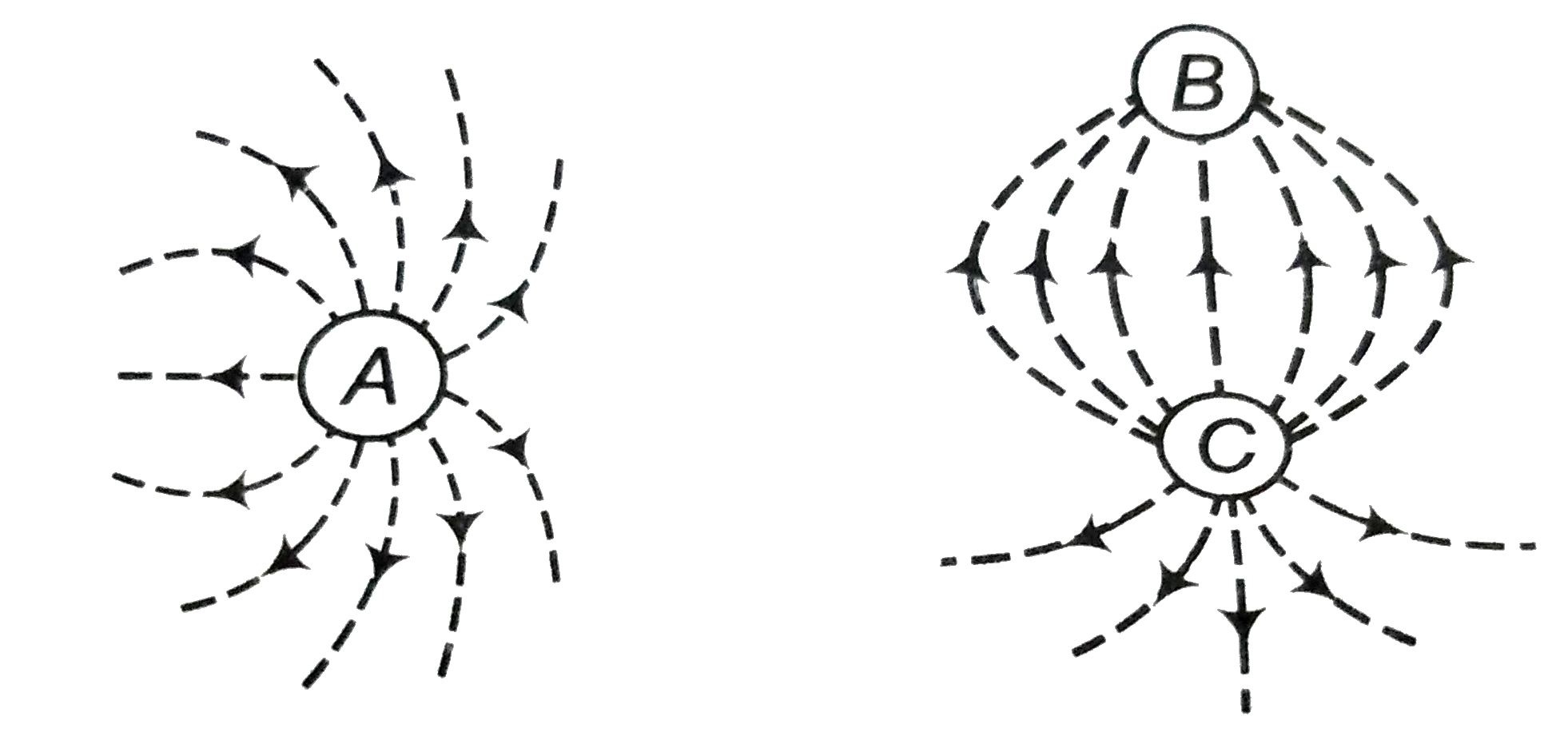
View SolutionThe electrostatic force of repulsion between two positively charged ions carrying equal charge is `3.7xx10^(-9)N`, when they are separated by a distance of `5Å`. How much electrons are missing from each ion?
View SolutionIn figure two positive charges `q_(2) and q_(3)` fixed along the Y-axis, exert a net electric force in the `+x` direction on a charge `q_(1)` fixed along the X-axis. If a positive charge Q is added at (x, 0), foce on `q_(1)`
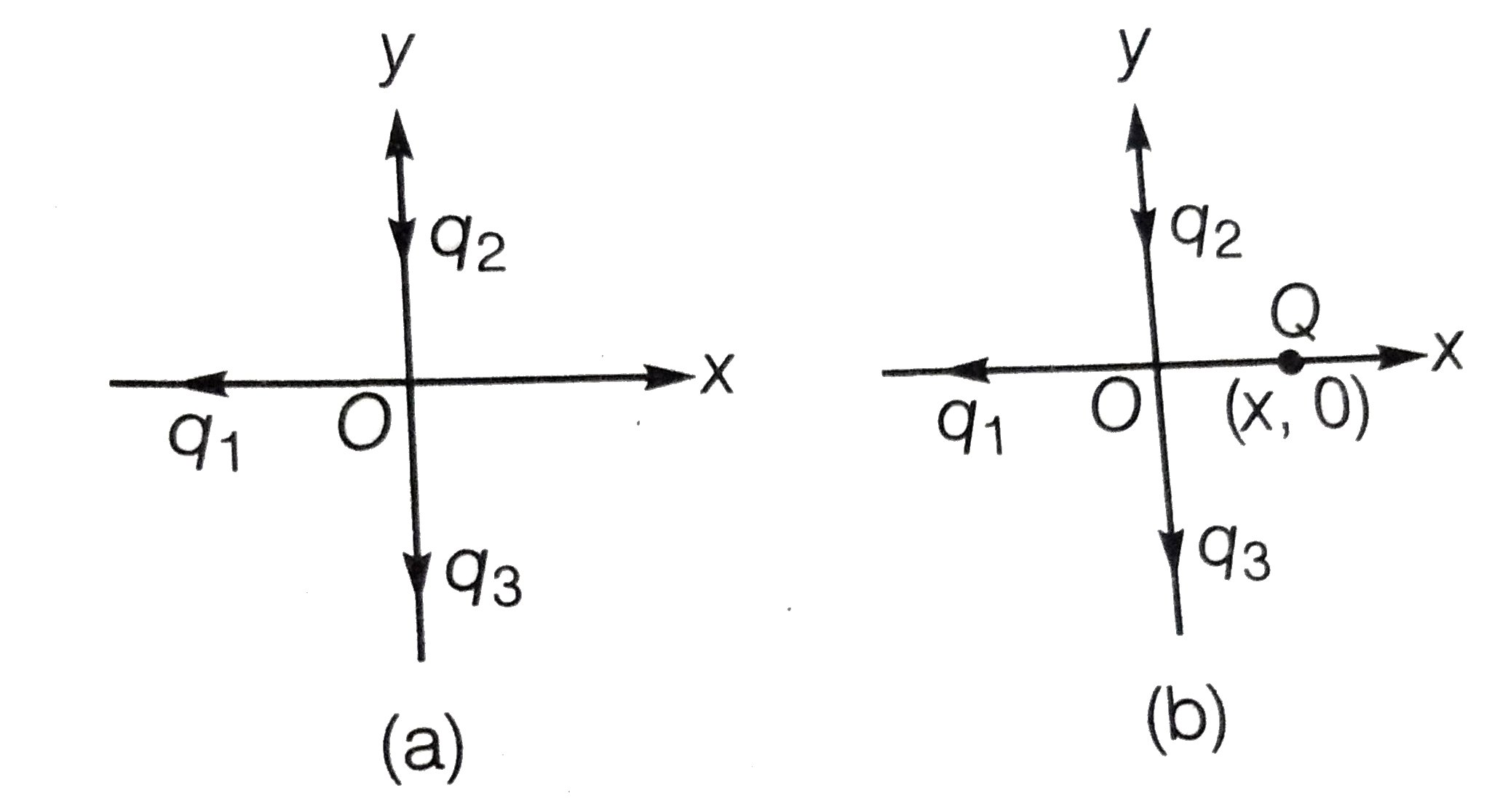
View SolutionIf a charge on the body is `1 nC`, then how many electrons are present on the body?
View SolutionWhen `10^(14)` electrons are removed from a neutral metal sphere , the charge on it becomes
View SolutionThe electric field in the space between the plates of a discharge tube is `3.24 xx 10^(4)NC^(-1)`. If mass of proton is `1.67xx10^(-27)` kg and its charge is `1.6xx10^(-19)C`, the force often the proton in the field is
View SolutionThere are two charged identical metal spheres A and B repel each other with a force `3xx10^(-5)N`. Another identical uncharged sphere C is touched with A and then placed at the mid-point between A and B. Net force on C is
View SolutionPick out the statement which is incorrect?
View SolutionTwo spheres carrying charges `+6muC and +9muC`, separated by a distance d, experiences a force of repulsion F. When a charge of `-3muC` is given to both the spheres and kept at the same distance as before, the new force of repulsion is
View SolutionThe insulation property of air breaks down at `E=3xx10^(6) "volt"//meter`. The maximum charge that can be given to a sphere of diameter `5m` is approximately (in coulombs)
View SolutionThe unit of physical quantity obtained by the line integral of electric field is
View SolutionThe work done in carrying a charge q once round a circle of radius r with a charge Q at the centre is
View SolutionFour charges equal to `-Q` are placed at the four corners fo a square and a charge `q` is at its centre, If the system is in equilibrium the value of `q` si
View SolutionTwo small conducting spheres of equal radius have charges `+ 10 muC` and `-20 muC` respectively and placed at a distance R from each other. They experience force `F_(1)`. If they are brought in contact and separated to the same distance, they experience force `F_(2)`. The ratio of `F_(1)` to `F_(2)` is
View SolutionTwo positive ions , each carrying a charge `q` , are separated by a distance `d`.If `F` is the force of repulsion between the ions , the number of electrons missing from each ion will be (`e` being the charge on an electron)
View SolutionA charged particle of mass 0.003 g is held stationary in space by placing it in a downward direction of electric field of `6xx10^(4)NC^(-1)`. Then, the magnitude of charge is
View SolutionThe work done in carrying an electron from point A to a point B in an electric is 10 MJ. The potential difference `(V_(B)-V_(A))` is then
View SolutionA charge q is placed at the centre of the line joining two equal charges Q. The system of the three charges will be in equilibrium if q is equal to:
View SolutionA point charge q produces an electric field of magnitude `2NC^(-1)` at a point distance 0.25 m from it. What is the value of charge ?
View SolutionA hollow metallic sphere of radius 10 cm is given a charge of `3.2 xx 10^(-9) C.` The electric intensity at a point 4 cm from the center is
View SolutionIf infinite parallel plane sheet of a metal is charged to charge density `sigma` coulomb per square metre in a medium of dielectric constant K. Intensity of electric field near the metallic surface will be
View SolutionThree identical charges are fixed at the corners of an equilateral triangle . If the force between any two charges is `F`, then the net electric force on each will be
View SolutionCharge `q_(1) = +6.0n C` is on y-axis at `y = + 3cm` and charge `q_(2) = -6.0 n C` is on y-axis at `y = -3 cm`. Calculate force on a test charge `q_(0) = 2 n C` placed on X-axis at `x = 4cm`.
View SolutionTwo particles of charges `q_(1)=+8q and q_(2)=-2q` are placed as shown. At what point away from `q_(2)` on the X-axis, can a proton be placed so that it is in equilibrium?

View SolutionFigure shows electric field lines in which an electric dipole p is placed as shown in figure. Which of the following statements is correct ?
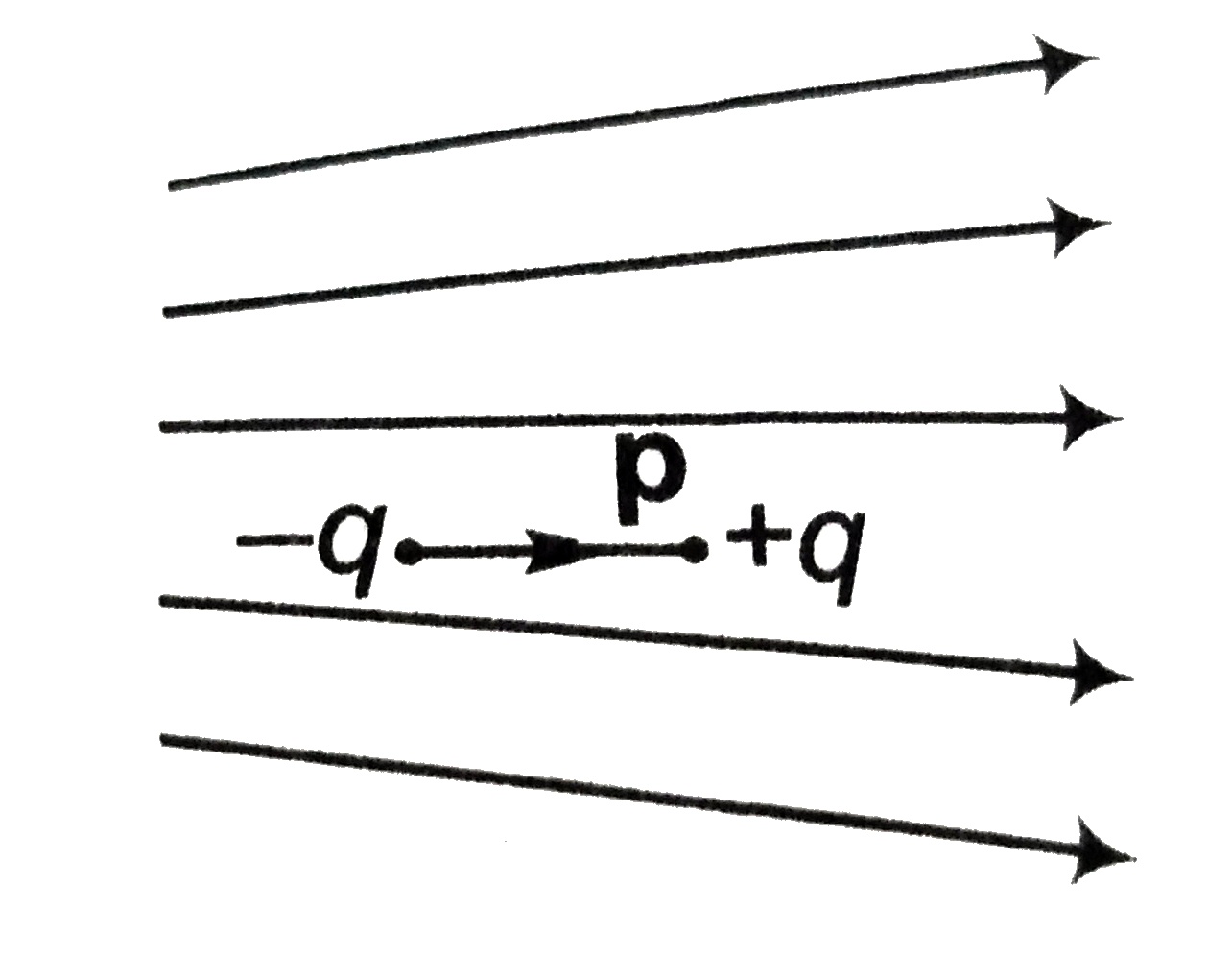
View SolutionCharge `q_(2)` of mass m revolves around a stationary charge `q_(1)` in a circular orbit of radius r. The orbital periodic time of `q_(2)` would be
View SolutionIf `10^(10)` electrons are acquired by a body every second, the time required for the body to get a total charge of C will be
View SolutionThe electric potential V at any point x,y,z (all in metre) in space is given by `V=4x^2` volt. The electric field at the point `(1m, 0, 2m)` is ……………`V/m`.
View SolutionAmong two discs A and B, first have radius 10 cm and charge `10^(_6) -mu`C and second have radius 30 cm and charge `10^(-5)`- C. When they are touched, charge on both `q_(A)` and` q_(B)` respectively will, be
View SolutionA cylinder of radius R and length L is placed in a uniform electric field E parallel to the axis. The total flux for the surface of the cylinder is given by
View Solution`q_(1),q_(2),q_(3) and q_(4)` are point charges located at points as shown in figure and S is the spherical gaussian surface of radius R. Which of the following is true according to the Gauss' theorem?
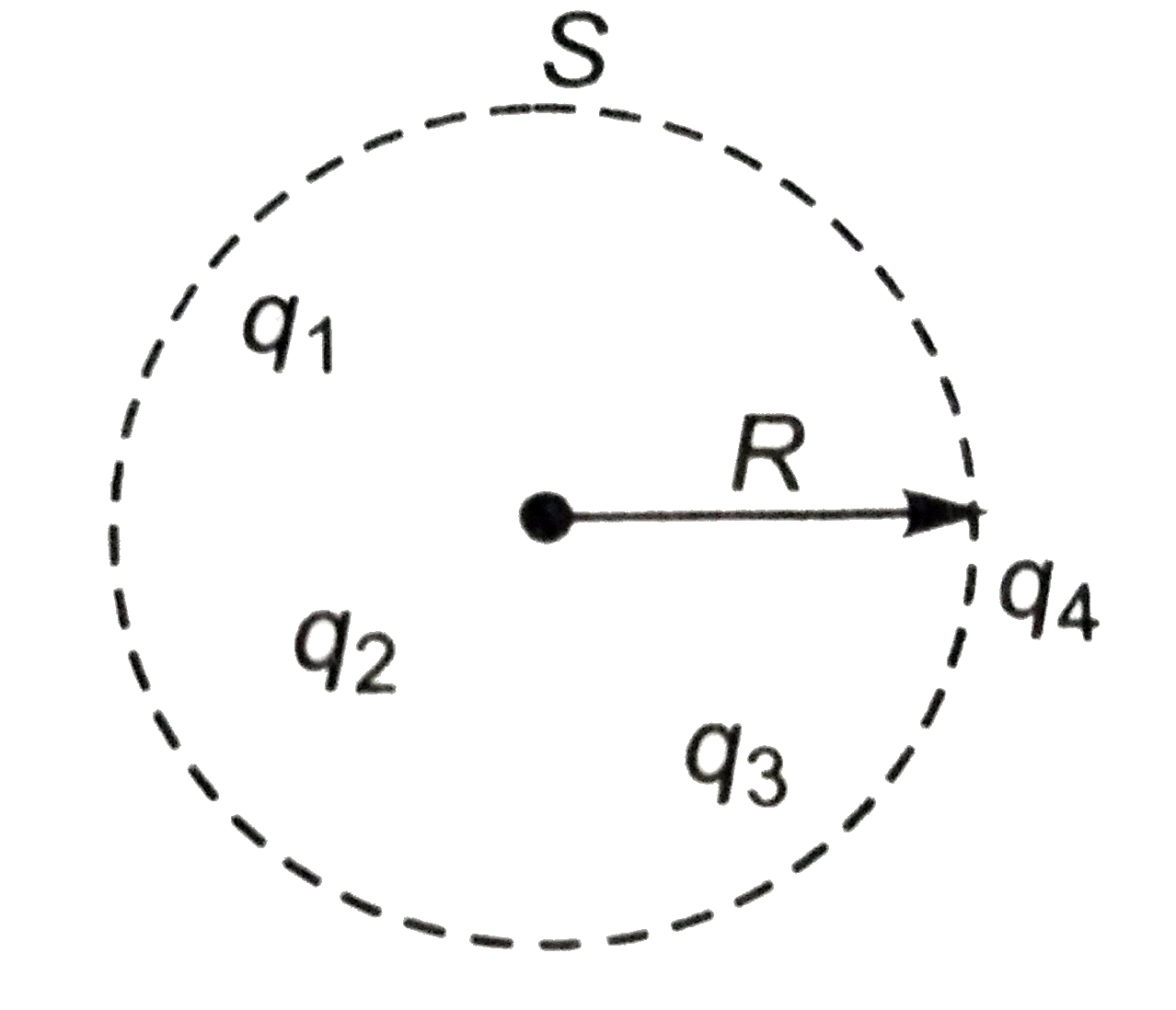
View SolutionIn a region of space, the electric field is given by `vecE = 8hati + 4hatj + 3hatk`. The electric flux through a surface of area 100 units in the xy plane is
View SolutionThree identical point charges as shown in figure, are placed at the vertices of an isosceles right angied triangle. Which of the numbered vectors coincides in direction with the electric field at the mid-point M of the hypotenuse?
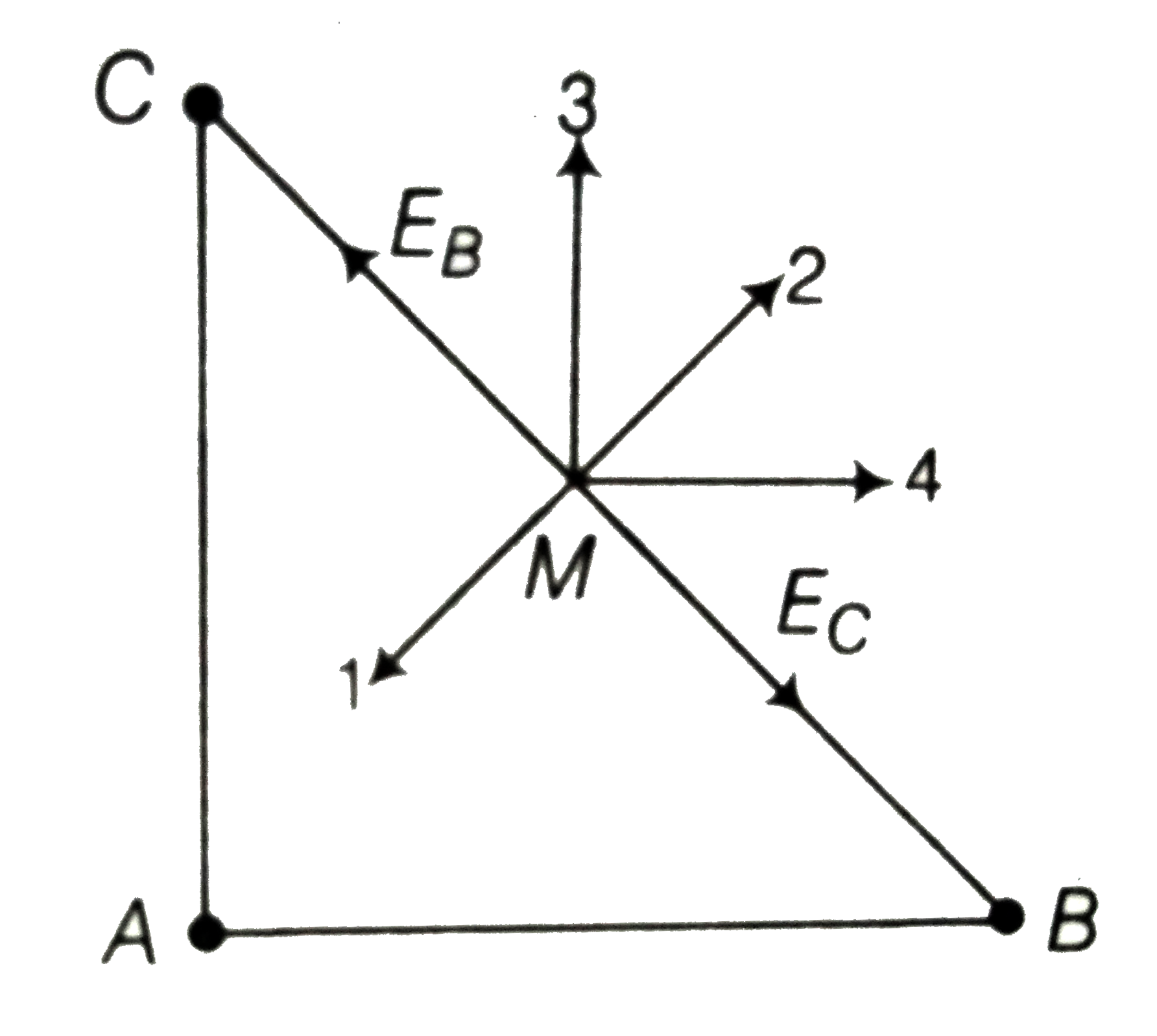
View SolutionA charge `Q` is enclosed by a Gaussian spherical surface of radius `R`. If the radius is doubled, then the outward electric flux will
View SolutionA charge q is placed at the centre of a cube of side `l` what is the electric flux passing through two opposite faces of the cube ?
View SolutionThree infinitely charged sheets are kept parallel to x-y plane having charge densities as shown. Then the value of electric field at P is

View SolutionIn figure `+Q` charge is located at one of the edge of the cube, then electric flux through cube due to `+Q` charge is

View SolutionA hollow cylinder has a charge q C within it. It `phi` is the electric flux in unit of voltmeter associated with the curved surface B, the flum linked with the plane surface A in unit of V - m will be
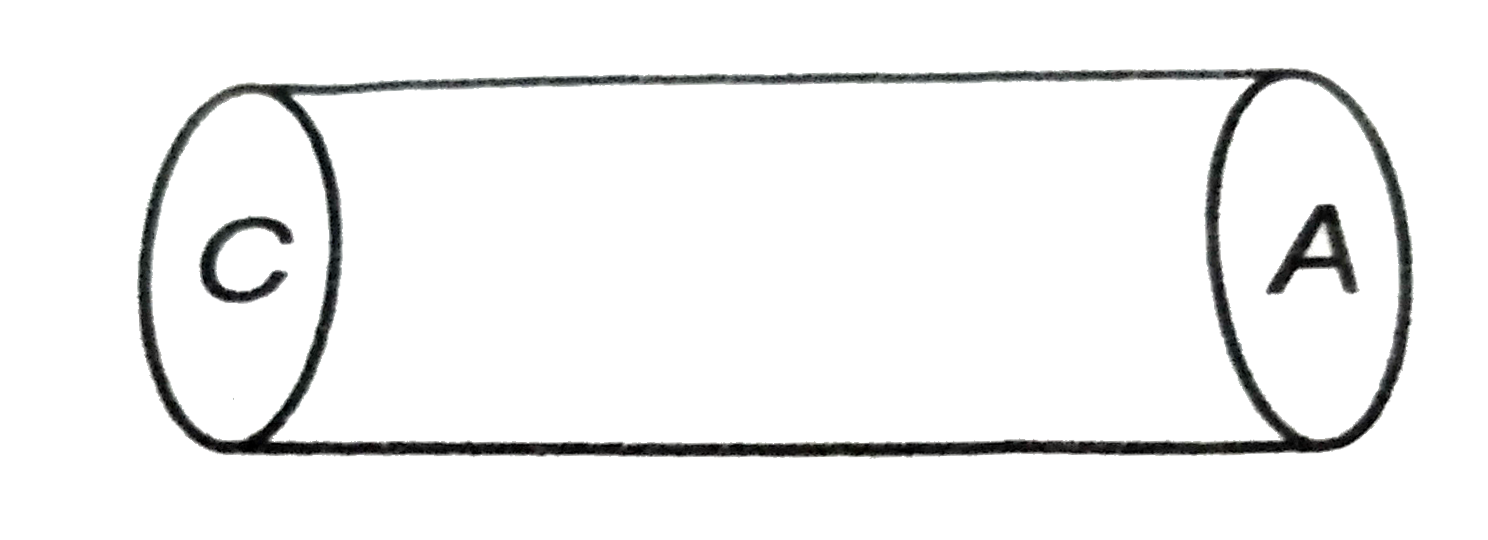
View SolutionA charge `q` is located at the centre of a cube. The electric flux through any face is
View SolutionA spherical conductor of radius 2 cm is uniformly charged with 3 nC. What is the electric field at a distance of 3 cm from the centre of the sphere?
View SolutionFive charges `q_(!),q_(2),q_(3),q_(4)` and `q_(5)` are fixed at their positions as shown in figure. S is a Gaussian surface.
The Gauss' theorem is given by `ointE.dS=(q)/(epsilon_(0))`
Which of the following statements is correct ?
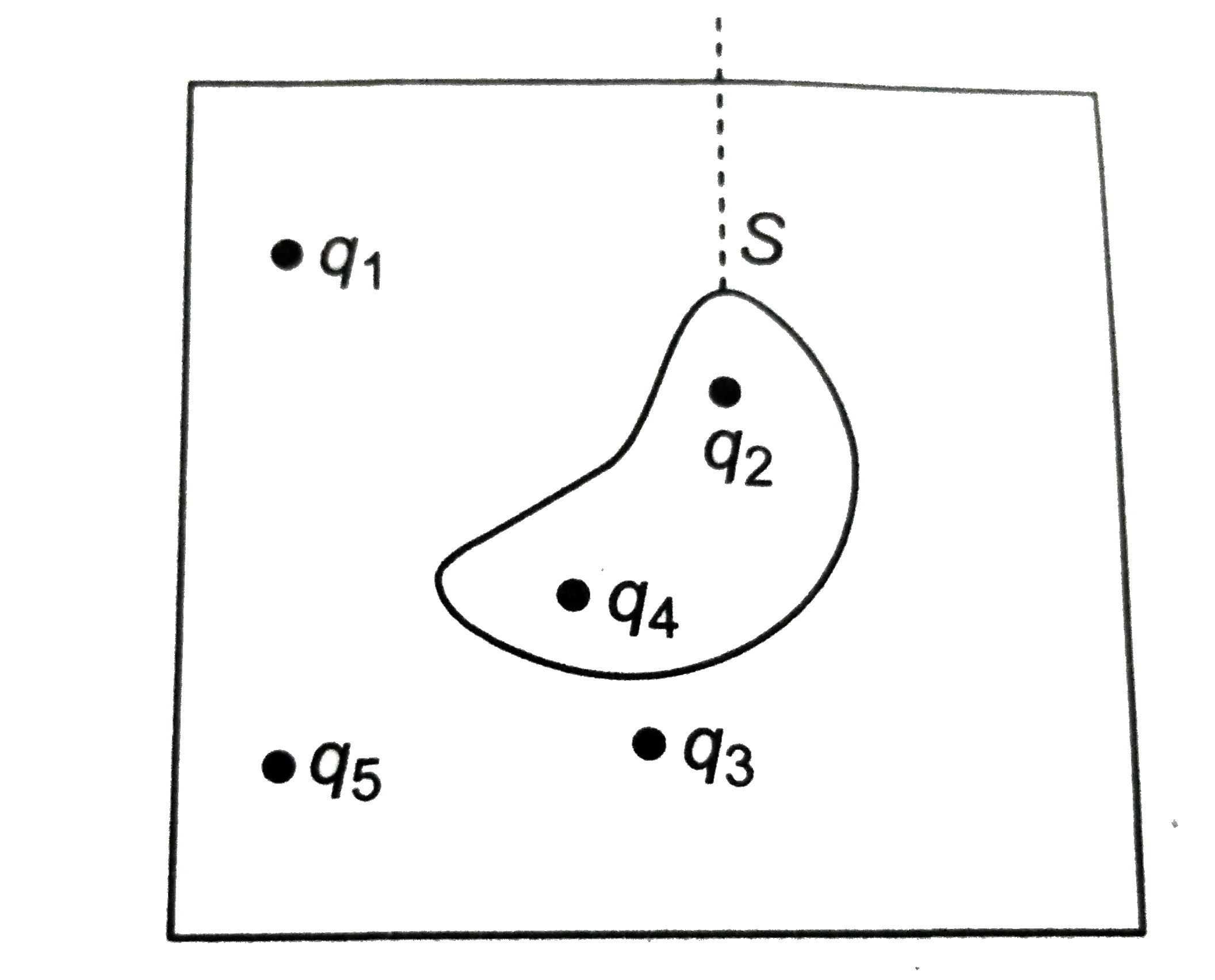
View SolutionShown below is a distribution of charges. The flux of electric field due to these charges through the surface is
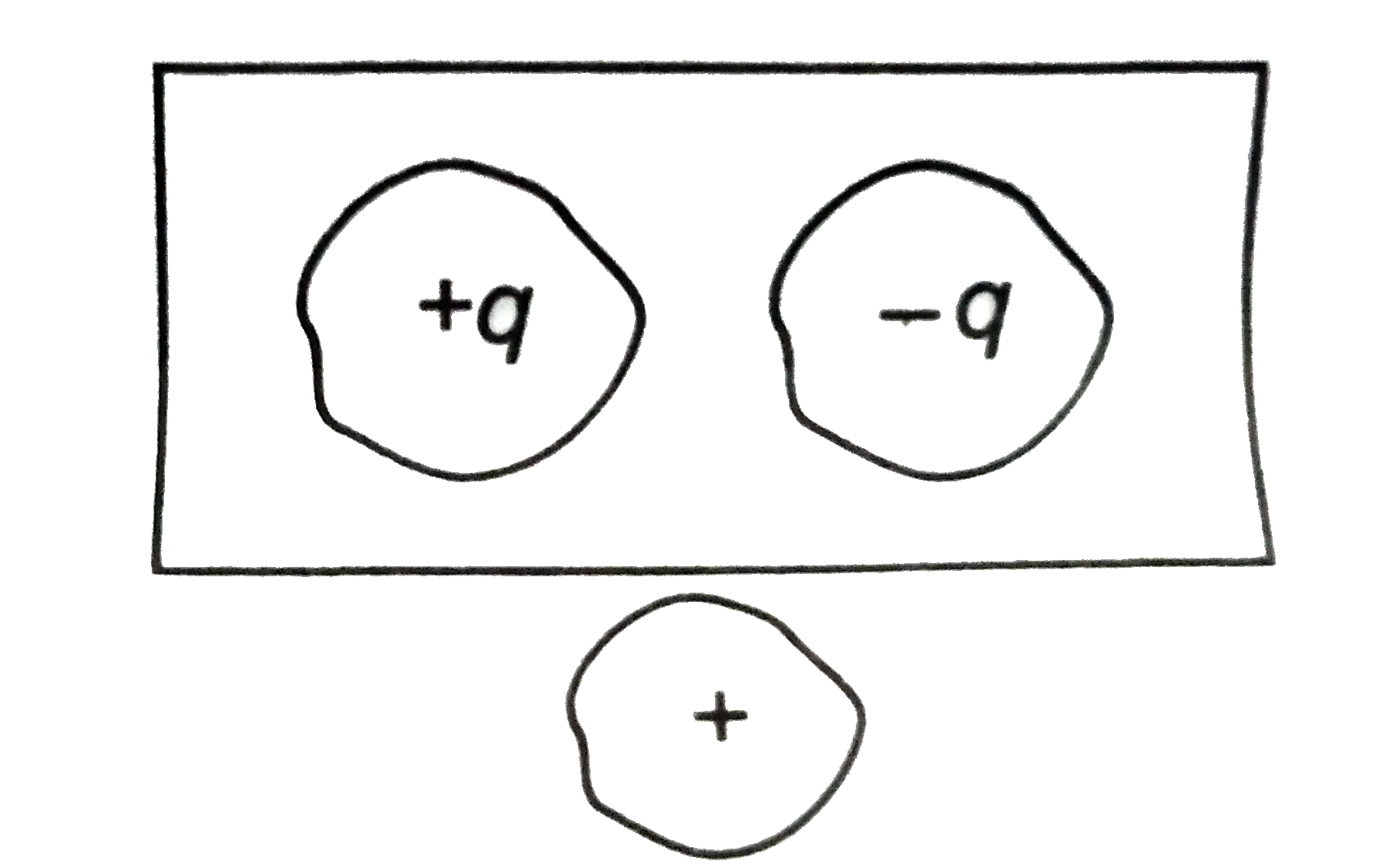
View SolutionTwo electric dipoles of moment `P` and `64P` are placed in opposite direction on a line at a distance of `25 cm`. The electric field will be zero at point between the dipoles whose distance from the dipole of moment `P` is
View SolutionThe electric flux of Gaussian surface A that encloses that charged particles in free is
(Given, `q_(1)=-14nC, q_(2)=78.85nC, q_(3)=-56nC`)

View SolutionFigure shows the portions of the infinite parallel non-conducting sheets having the magnitude of the surface charge densities `sigma_((+))=6.8muCm^(2) and sigma_((-))=4.3muCm^(2)` for the positively and negatively charged sheets, respectively. Find the electric field E between the sheets.
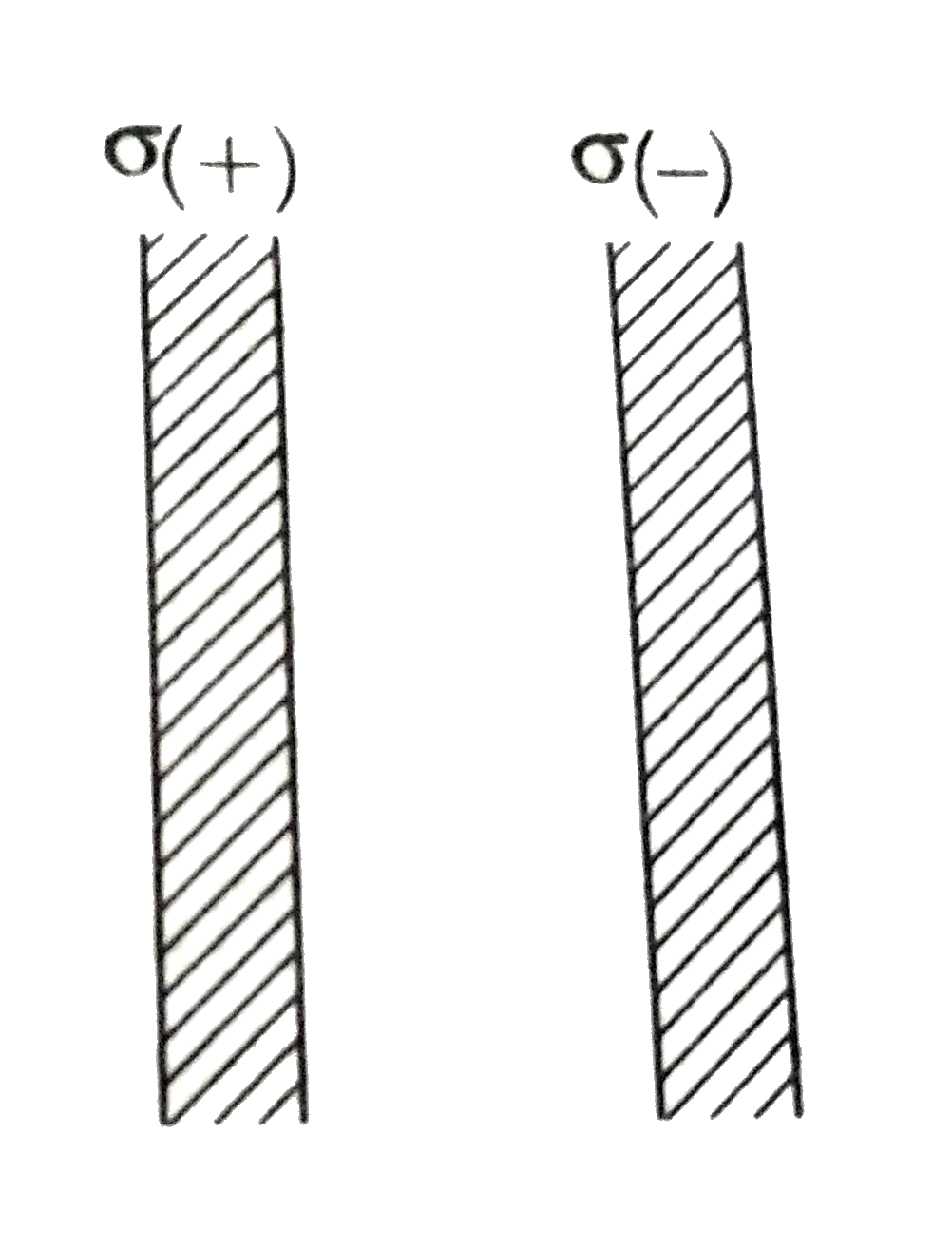
View SolutionThe electric flux through a chlosed surface area S enclosing charge Q is `phi`. If the surface area is doubled, then the flux is
View SolutionFor a given surface the Gauss's law is stated as`oint vecE.dvecA=0`. From this we can conclude that
View SolutionElectric charge is uniformly distributed along a along straight wire of radius `1 mm`. The charge per centimeter length of the wire is `Q` coulomb. Another cyclindrical surface of radius `50 cm` and length `1 m` symmetrically enclose the wire ask shown in figure. The total electric flux passing through the cyclindrical surface is
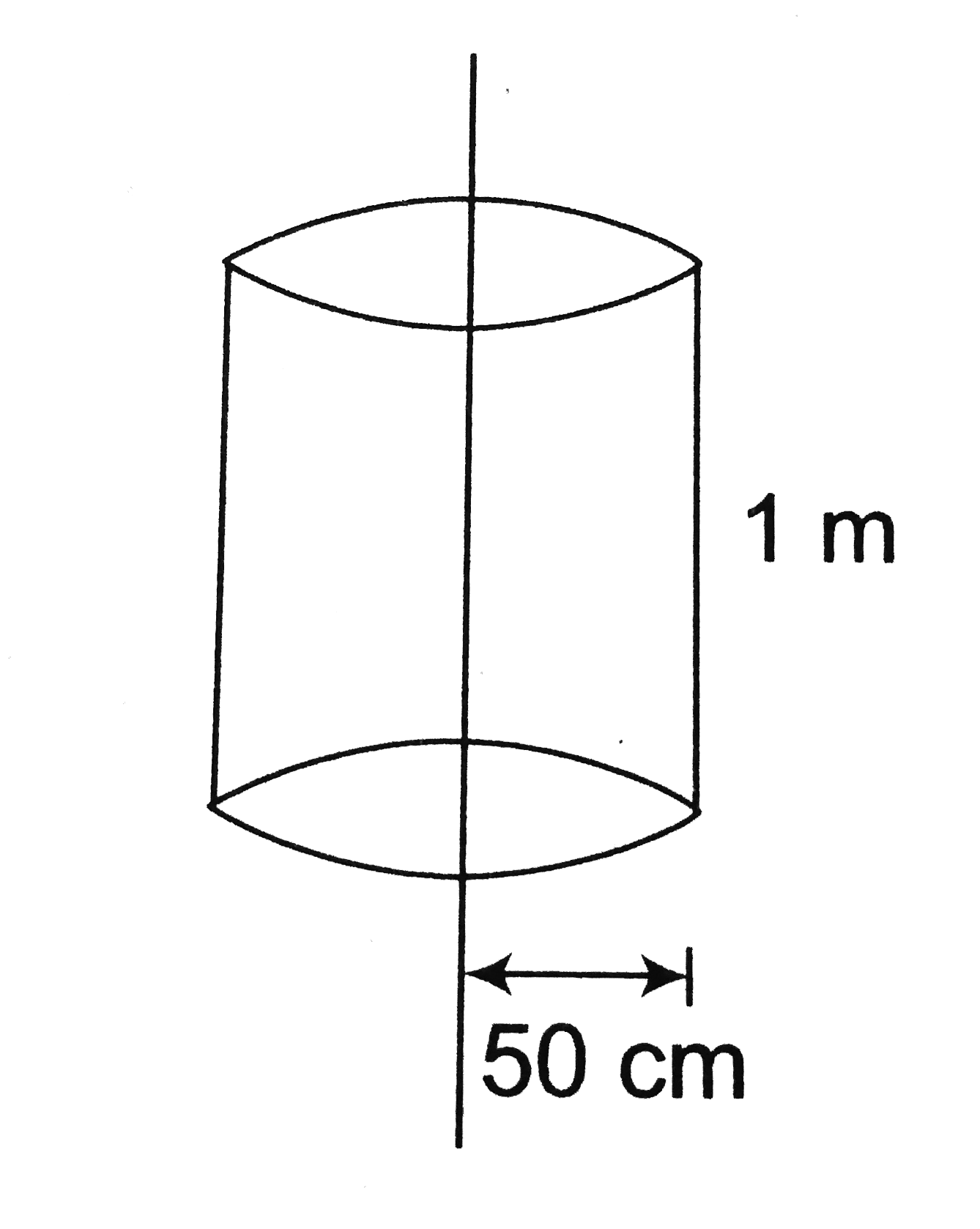
View SolutionThe inward and outward electric flux for a closed surface unit of `N-m^(2)//C` are respectively `8xx10^(3)` and `4xx10^(3)`. Then the total charge inside the surface is [where `epsilon_(0)=` permittivity constant]
View SolutionThe electric charges are distributed in a small volume. The flux of the electric field through a spherica surface of radius 10 cm surrounding the total charge is `20 V - m`. The flux over a concentric sphere of radius 20 cm will be
View SolutionIf the electric field given by `(5hat(i)+4hat(j)+9hat(k))`, then the electric flux through a surface of area 20 unit lying in the `yz`- plane will be
View SolutionTwo capacitors having capacitances `C_(1)` and `C_(2)` are charged with 120 V and 200 V batteries respectively. When they are connected in parallel now, it is found that the potential on each one of them is zero. Then,
View SolutionA parallel plate capacitor is charged and then isolated. The effect of increasing the plate separation on charge, potential and capacitance respectively are
View SolutionConducting sphere of radius `R_(1)` is covered by concentric sphere of radius `R_(2)`. Capacity of this combination is proportional to
View SolutionThe amount of work done in increasing the voltage across the plates of capacitor from 5 V to 10 V is W. The work done in increasing it from 10 V to 15 V will be
View SolutionA parallel-plate capacitor is connected to a battery. A metal sheet of negligible thickness is placed between the plates. The sheet remains parallel to the plates of the capacitor.
View SolutionA parallel plate air capacitor consists of two circular plates of diameter `8 cm` . At what distance should the plates be held so as to have the same capacitance as that of a sphere of a diameter `20 cm` ?
View SolutionA parallel plate capacitor is made by stacking n equally spaced plates connected alternatively. If the capacitance between any two adjacent plates is 'C' then the resultant capacitance is
View SolutionFigure below show regular hexagons with charges at the vertices. In which of the following cases the electric field at the centre is not zero
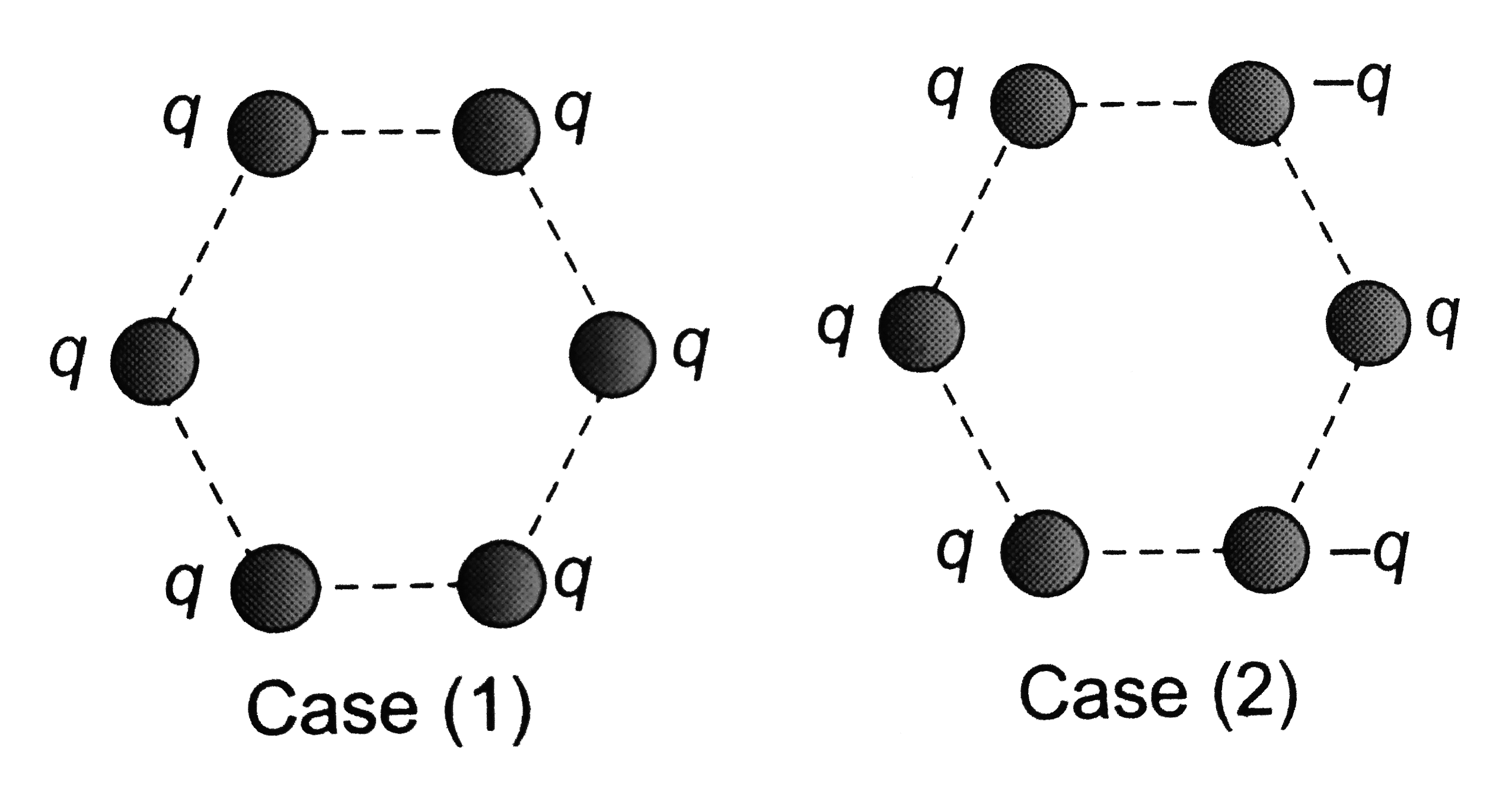
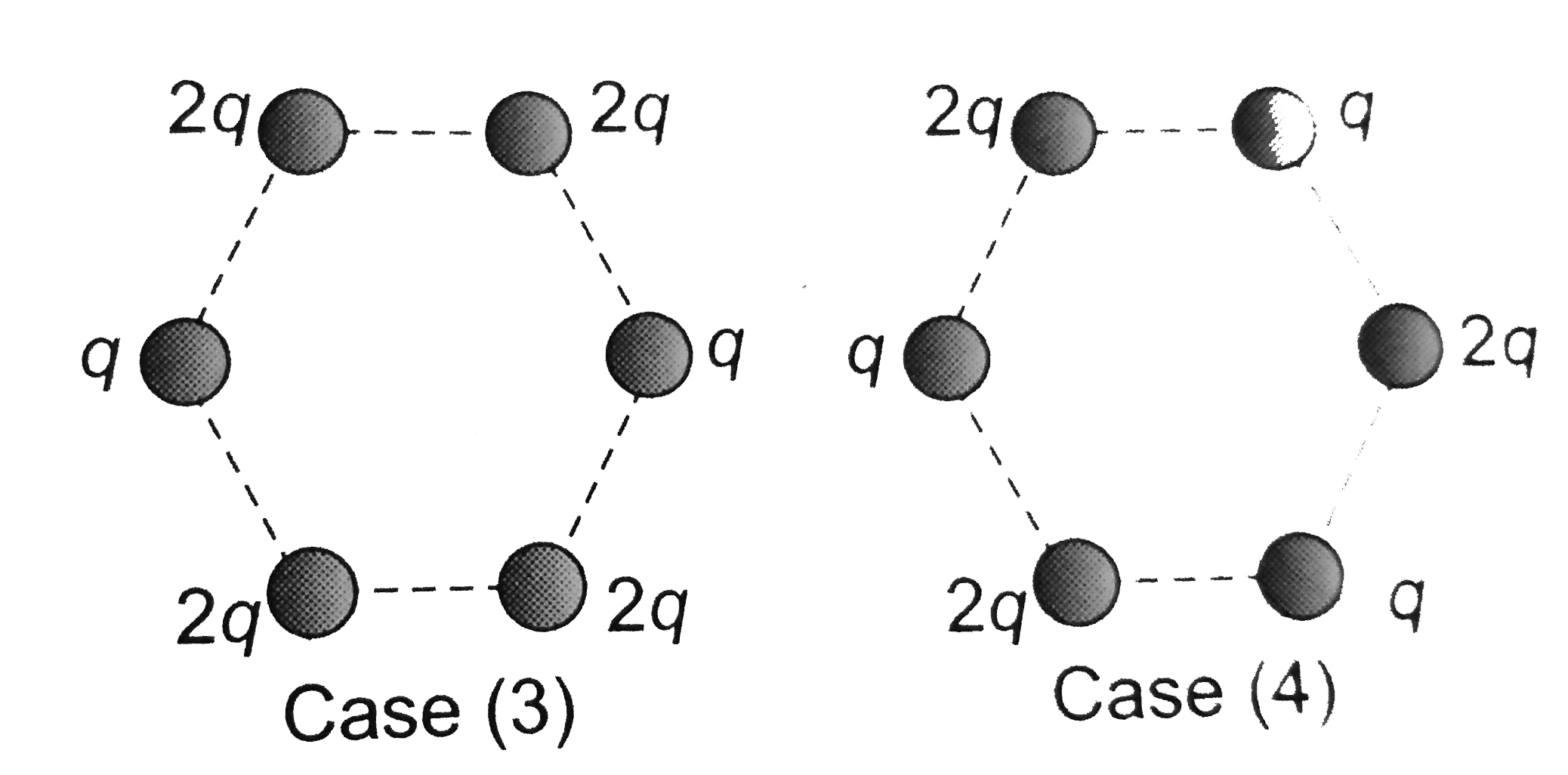
View SolutionA parallel plate condenser has a unifrom electric field `E (V//m)` in the space between the plates. If the distance between the plates is `d(m)` and area of each plate is `A(m^(2))` the energy (joule) stored in the condenser is
View SolutionA parallel plate condenser is charged by connected it to a battery. The battery is disconnected and a glass slab is introduced between the plates. Then
View SolutionA capacitor or capacitance `C_(1)` is charge to a potential V and then connected in parallel to an uncharged capacitor of capacitance `C_(2)`. The fianl potential difference across each capacitor will be
View SolutionHow many `1muF` capacitors must be connected in parallel to store a charge of 1 C with a potential of 110 V across the capacitors?
View SolutionThe `500 muF` capacitor is charged at a steady rate of `100 mu C//s`. The potential difference across the capacitor will be 10 V after an interval of
View SolutionA parallel plate air capacitor of capacitance `C` is connected to a cell of `emF V` and then disconnected from it. A dielectric slab of dielectric constant `K`, which can just fill the air gap of the capacitor, is now inserted in it. Which of the following is incorrect ?
View SolutionThe radii of the inner and outer spheres of a condenser are 9 cm and 10 m respectively. If the dielectric constant of the medium between the two sphere is 6 and charge on the inner sphere is `18xx10^(-9)C`, then the potential of inner sphere will be, if the other sphere is earthed
View SolutionAn unchanged capacitor with a solid dielectric is connected to a similar air capacitor charged to a potential of `V_(0).`. If the common potential after sharing of charges becomes V, then the dielectric constant of the dielectric must be
View SolutionTwo insulated metal spheres of raddi 10 cm and 15 cm charged to a potential of 150 V and 100 V respectively, are connected by means of a metallic wire. What is the charge on the first sphere?
View SolutionThe mean electric energy density between the plates of a charged capacitor is (here `q =` charge on the capacitor and `A =` area o fthe capacitor plate)
View SolutionA `10 muF` capacitor is charged to a potential difference of `50 V` and is connected to another uncharged capacitor in parallel. Now the common potential difference becomes `20` volt. The capacitance of second capacitor is
View Solution`n` small drops of same size are charged to `V` volts each .If they coalesce to from a single large drop, then its potential will be -
View SolutionPotential energy of two equal negative point charges `2muC` each held 1 m apart in air is
View SolutionThe work done in placing a charge of `8xx10^-18` coulomb on a condenser of capacity 100 micro-farad is
View SolutionThe capacitance of a parallel plate capacitor with air as medium is `3muF`. With the introduction of a dielectric medium between the plates, the capacitance becomes `15muF.` The permittivity of the medium is
View SolutionEnergies stored in capacitor and dissipated during charging a capacitor bear a ratio
View SolutionA copper plate of thickness b is placed inside a parallel plate capacitor of plate distance d and area A, as shwon in figure. The capacitance of capacitor is
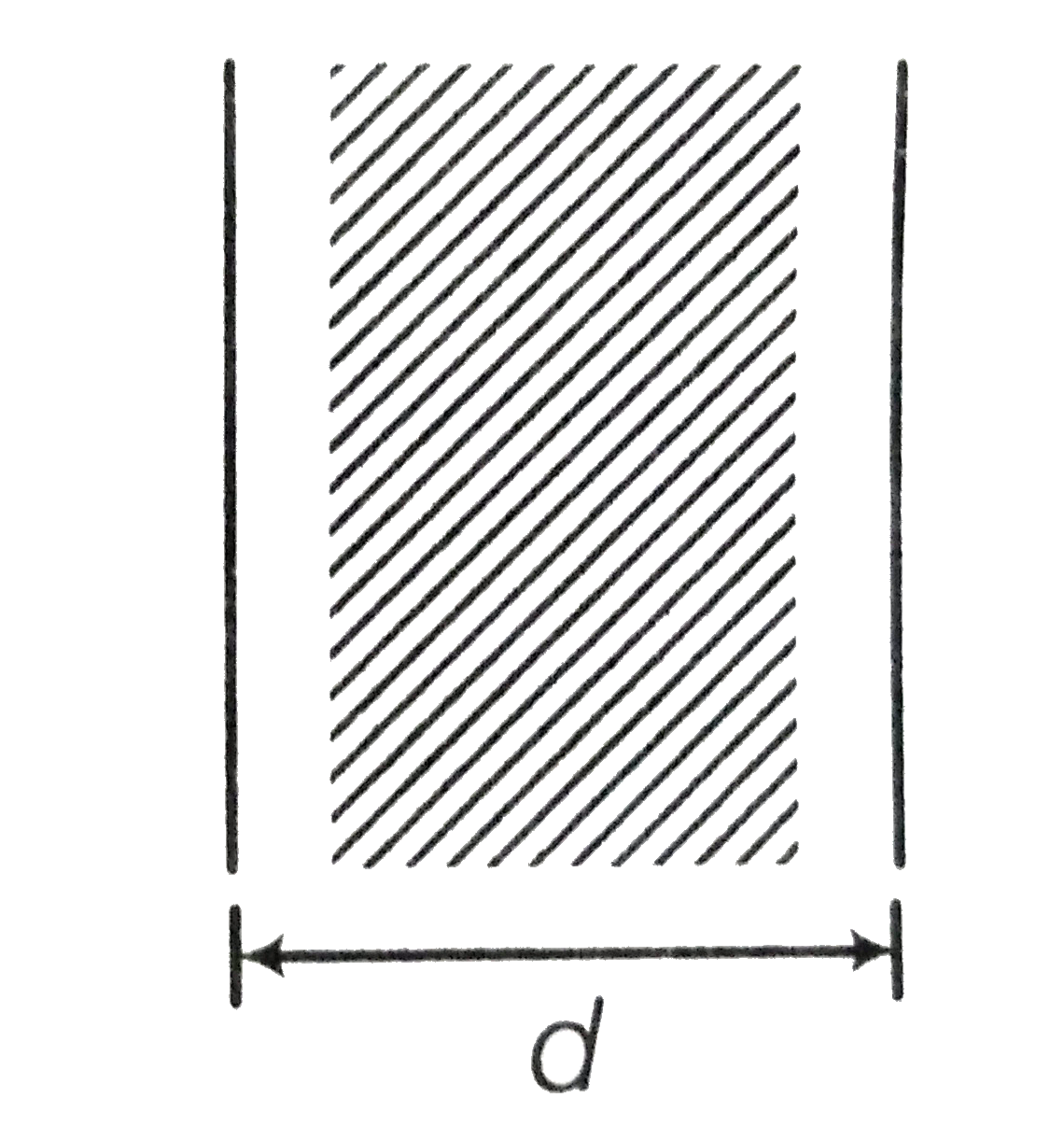
View SolutionIn the circuit shown below, capacitors A and B have identical geometry, but a material of dielectric constant 3 is present between the plates of B. the potential difference across A and B are respectively
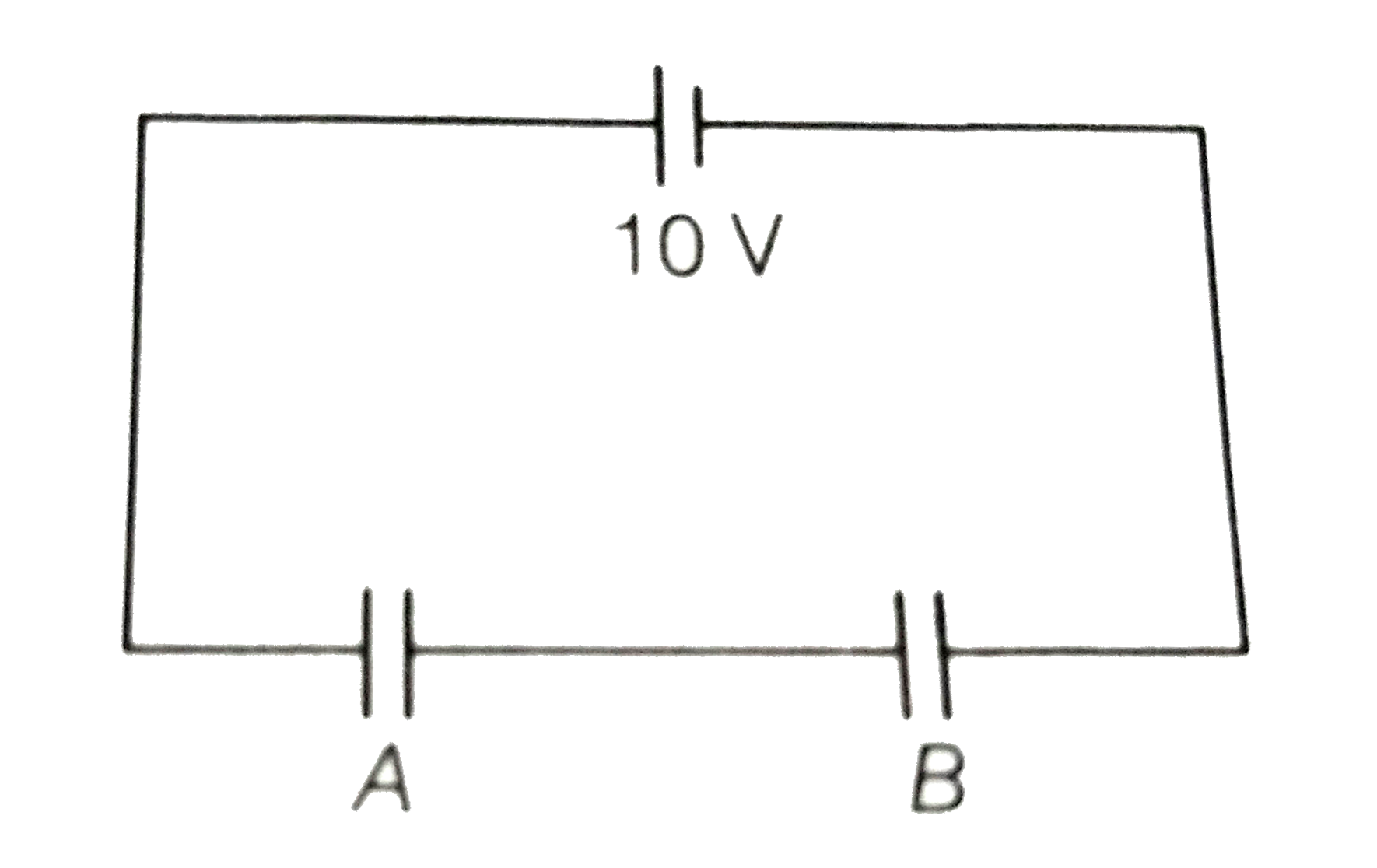
View SolutionThe equivalent capacitance of the combination of three capacitors each of capacitance C between A and B as shown in figure, is

View SolutionTwo capacitors `C_(1) and C_(2)` are connected in a circuit as shown in figure. The potential difference `(V_(A)-V_(B))` is
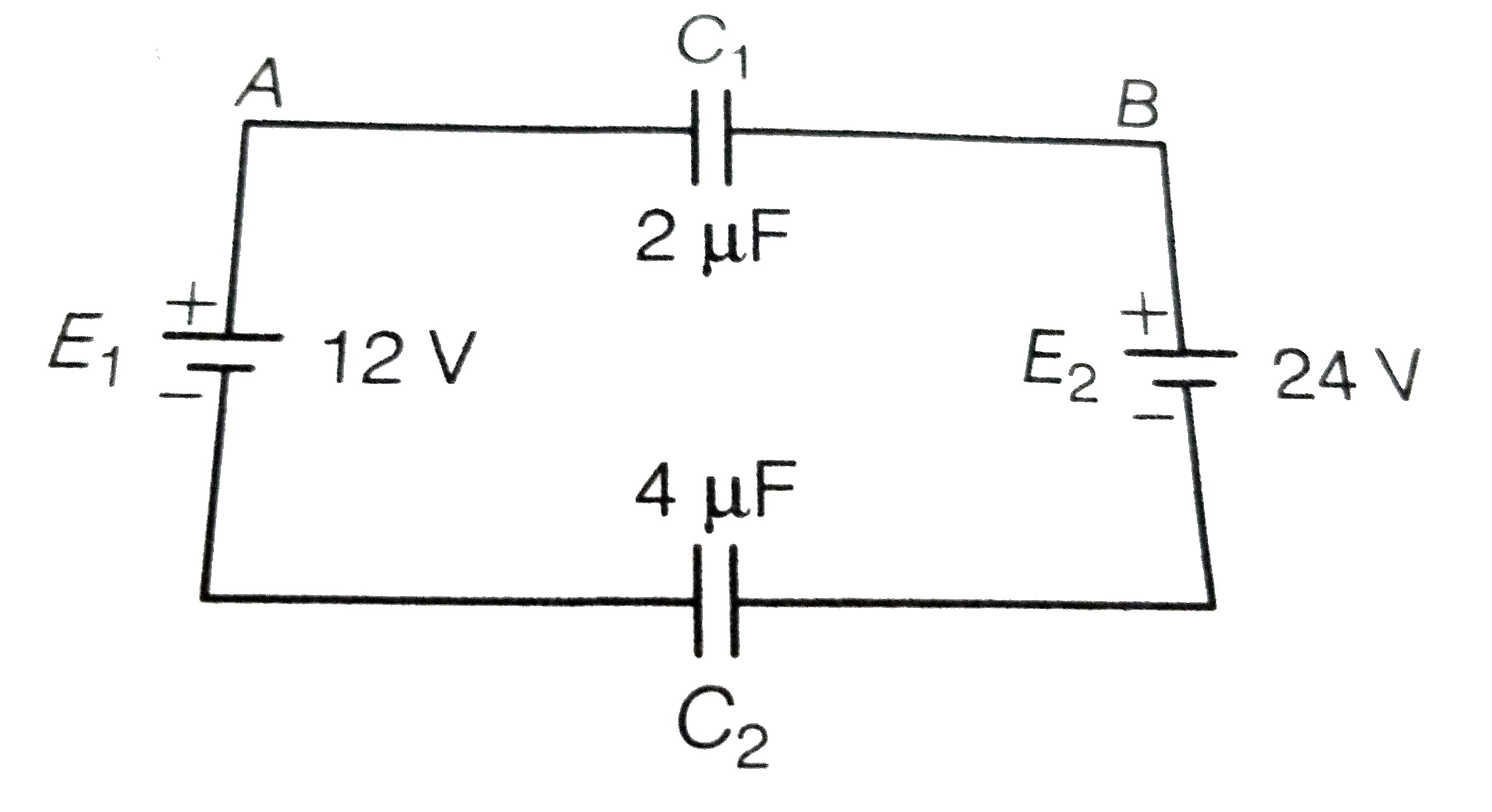
View SolutionA parallel plate capacitor is made of two dielectric block in series. One of the blocks has thickness `d_(1)` and dielectric constant `K_(1)` and the other has thickness `d_(2)` and dielectric constant `K_(2)` as shown in figure. This arrangement can be thought as a dielectric slab of thickness `d(=d_(1)+d_(2))` and effective dielectric constant K. The K is equal to
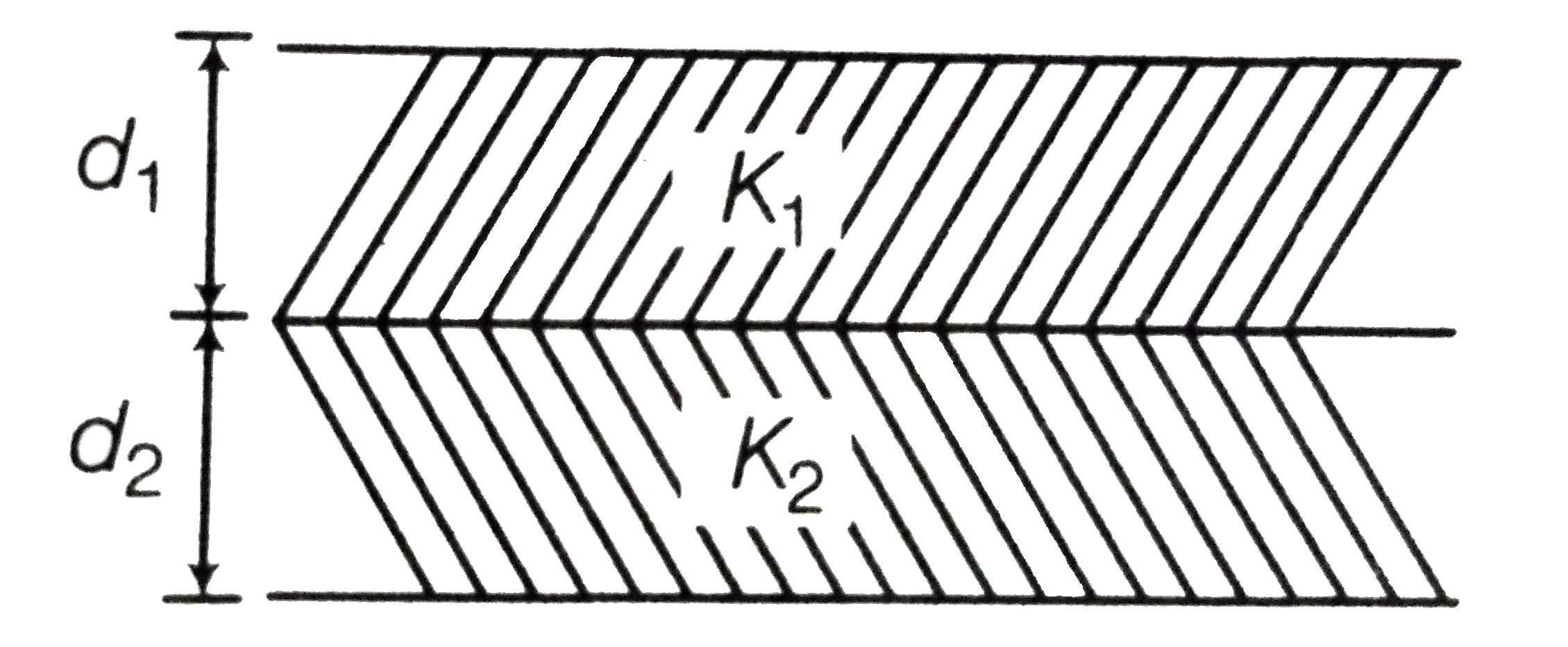
View SolutionIn the circuit shown, a potential difference of 90 V is appllied across AB. The potential difference between the points P and Q is
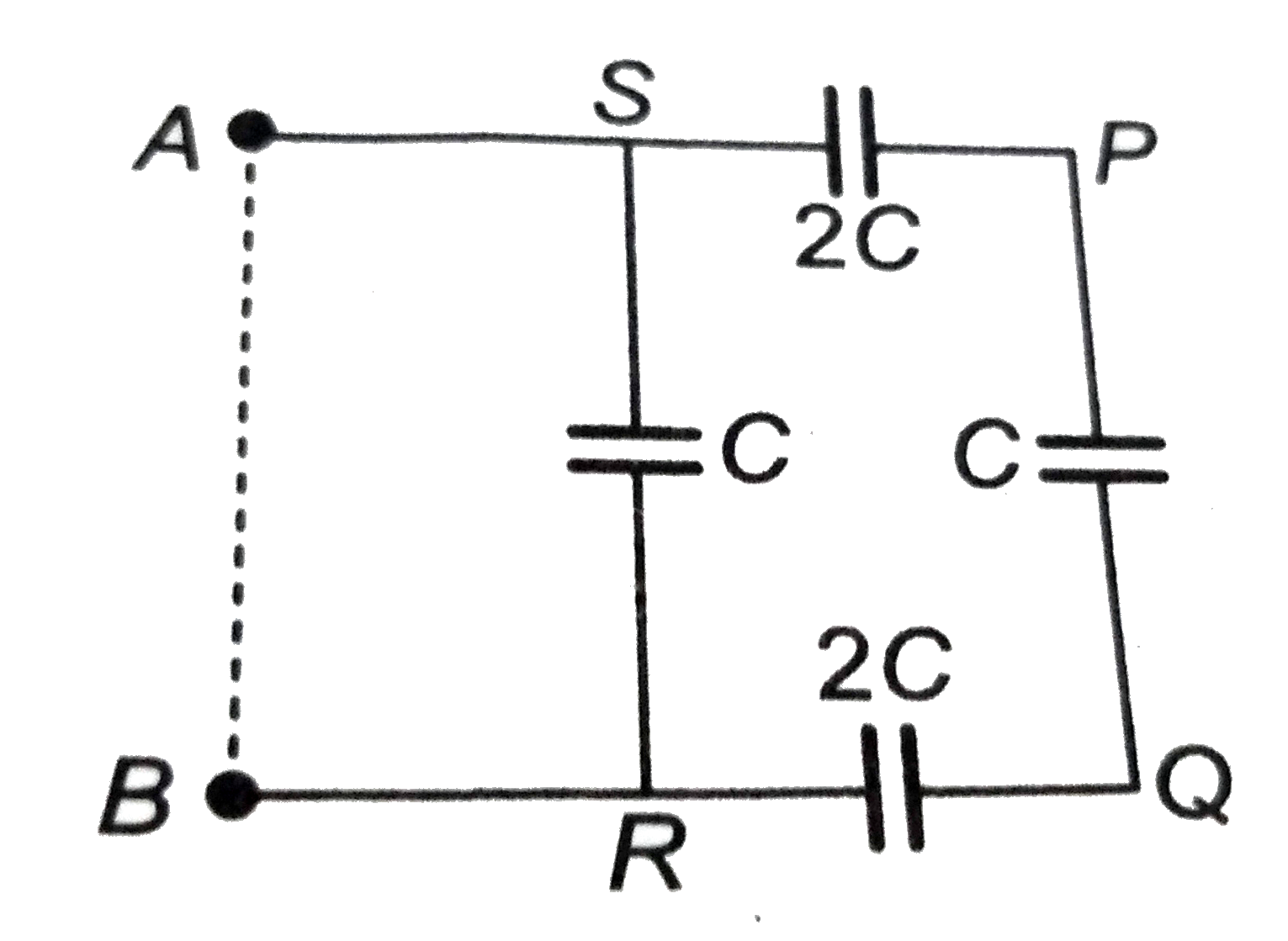
View SolutionA network of four capacitors of capacities equal to `C_(1)=C,C_(2)=2C, C_(2)=3C and C_(4)=4C` are connected to a battery as shown in the figure.
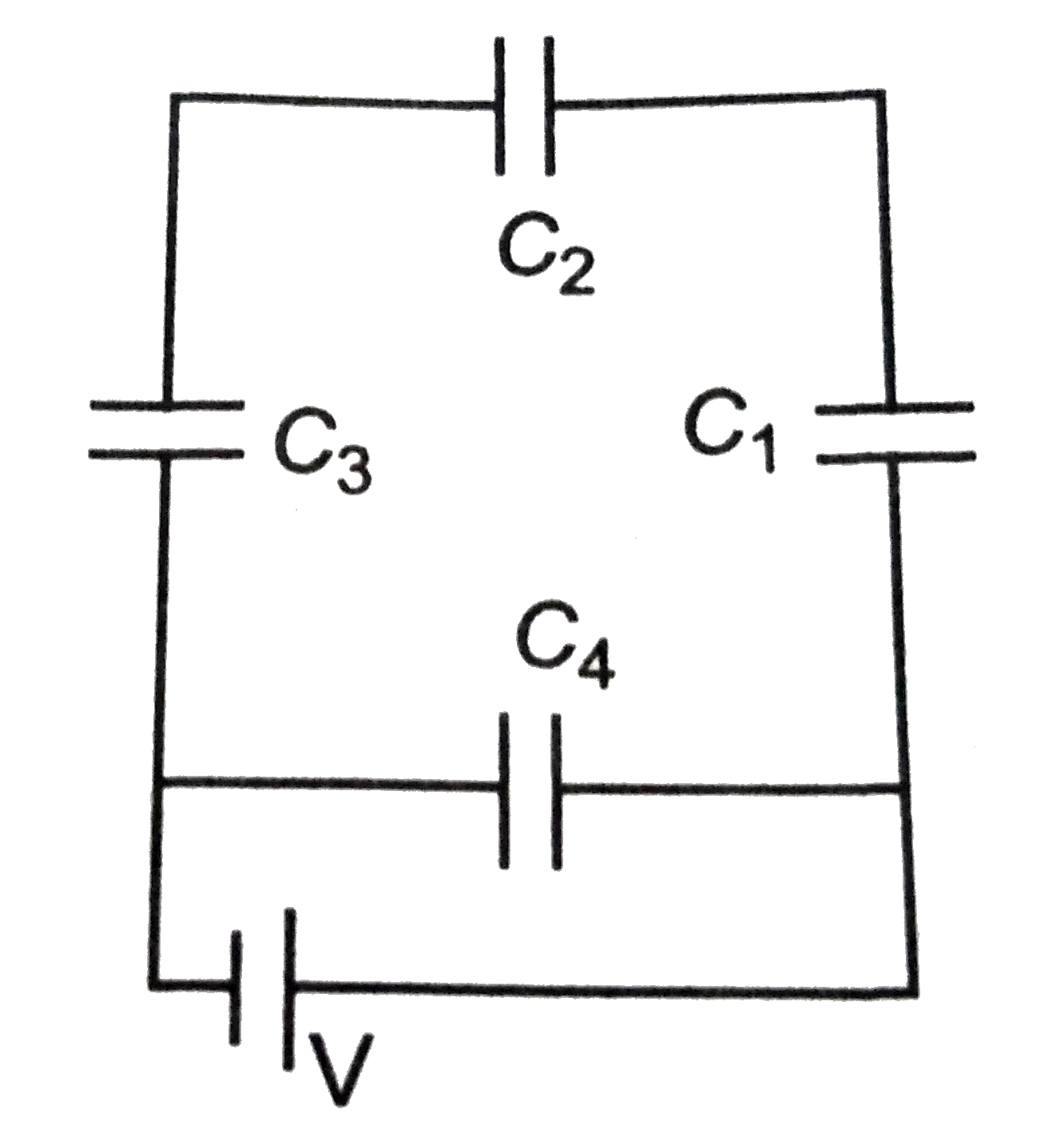
The ratio of the charges `C_(2)` and `C_(4)` is
View SolutionA series combination of `n_(1)` capacitors, each of value `C_(1)`, is charged by a source of potential difference `4 V`. When another parallel combination of `n_(2)` capacitors, each of value `C_(2)`, is charged by a source of potential difference `V`, it has same (total) energy stored in it, as the first combination has. the value of `C_(2)`, in terms of `C_(1)`, is then
View SolutionIn the connections shown in the adjoining figure, the equivalent capacity between points A and B will be

View SolutionParallel plate capacitor is constructed using three different dielectric materials as shown in the figure.
The parallel plates, across with a potential difference is applied of area A `"metre"^(2)` and separated by a distance d metre. The capacitance across A and B is
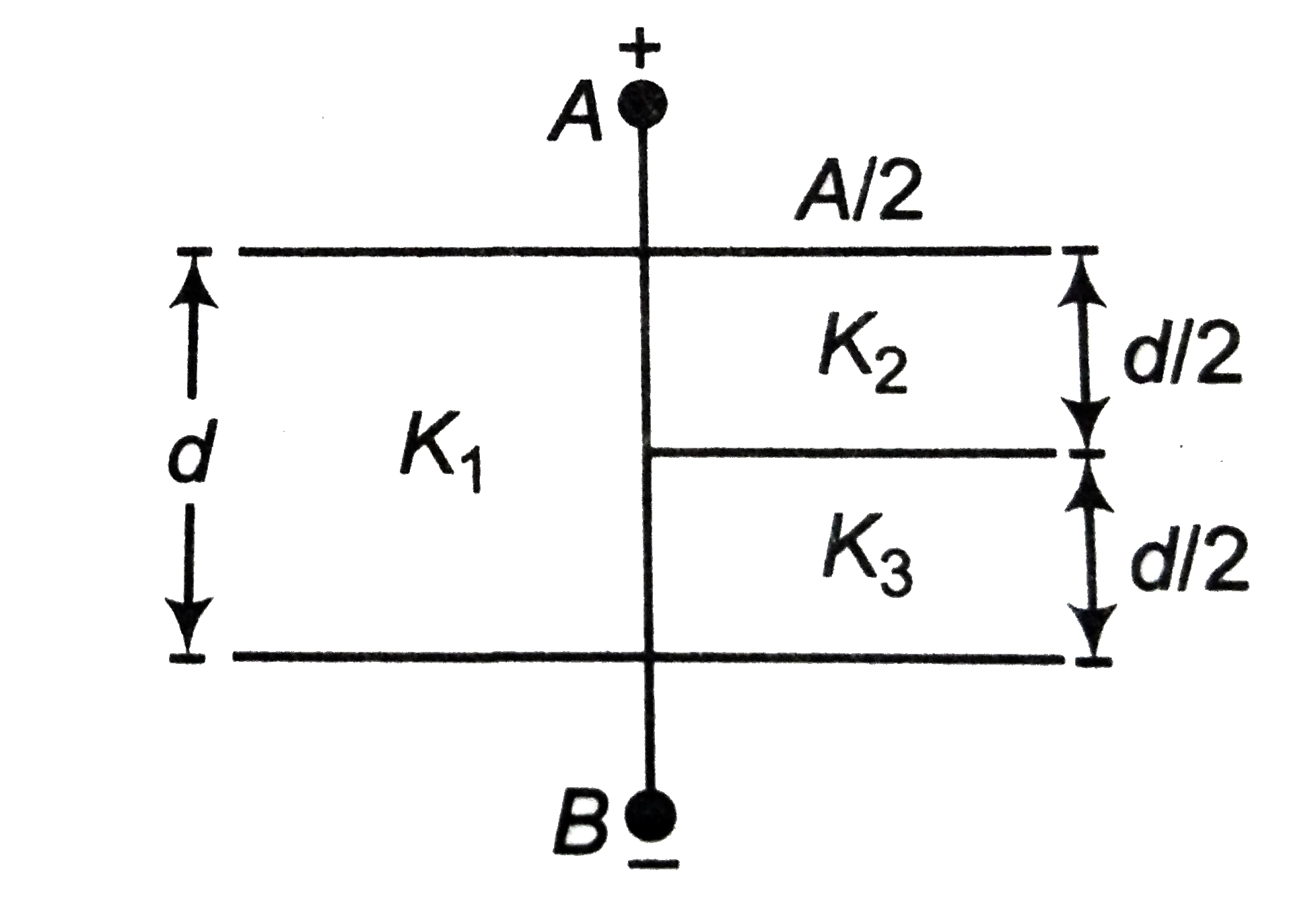
View SolutionThe total energy stored in the condenser system shown in the figure will be

View SolutionTwo capacitor `C_(1)=2muF and C_(2)=6muF` are in series order connected is parallel to a third capacitor `C_(3)=4muF.` This combination is connected to 2 V battery. In charging these capacitor energy consumed by the battery is
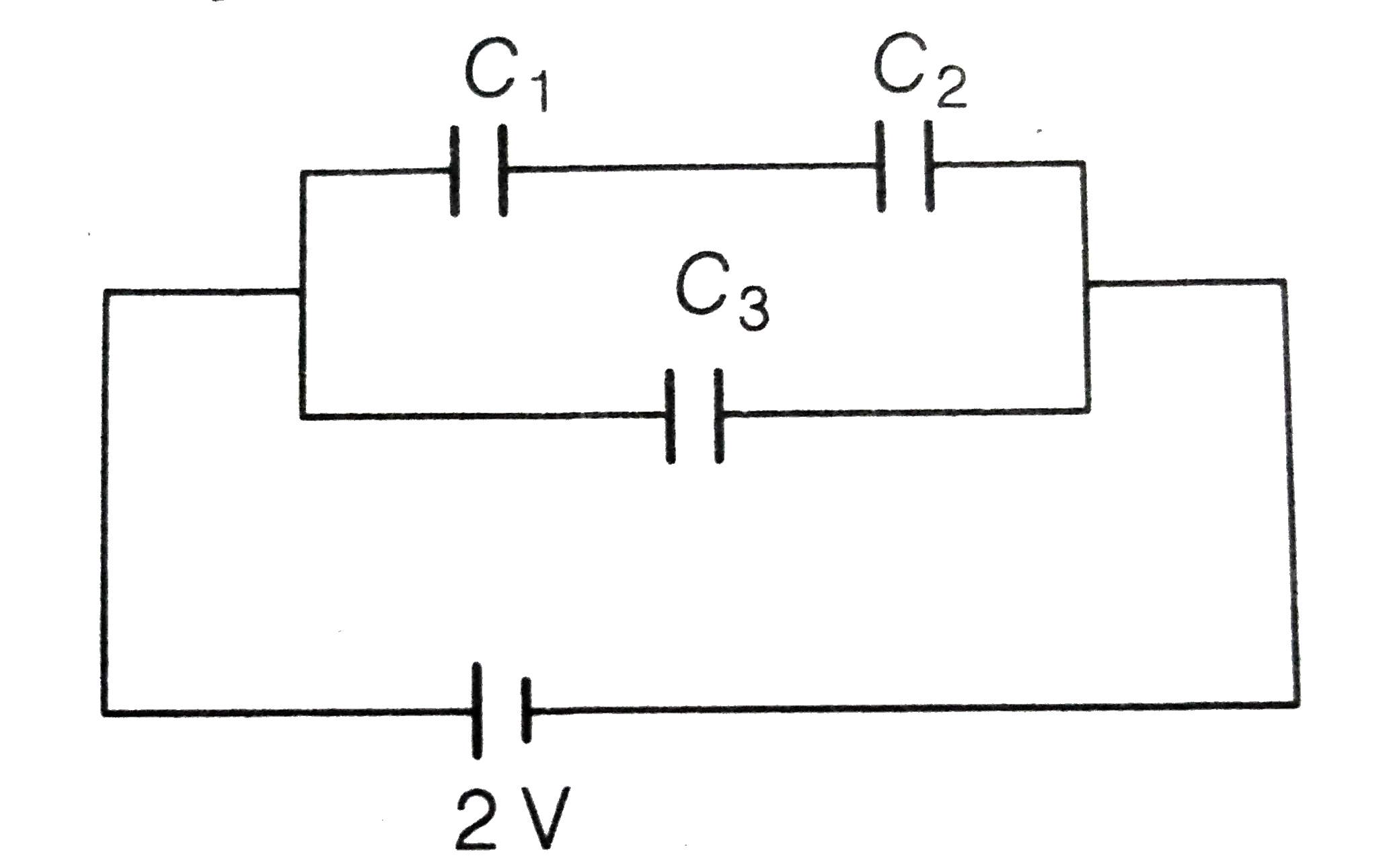
View Solution
PRACTICE EXERCISE (Exercise 1 (TOPICAL PROBLEMS)) questions and complete solutions for chapter ELECTROSTATICS of MHTCET PREVIOUS YEAR PAPERS AND PRACTICE PAPERS of Class 12